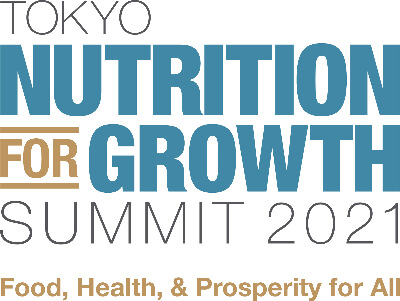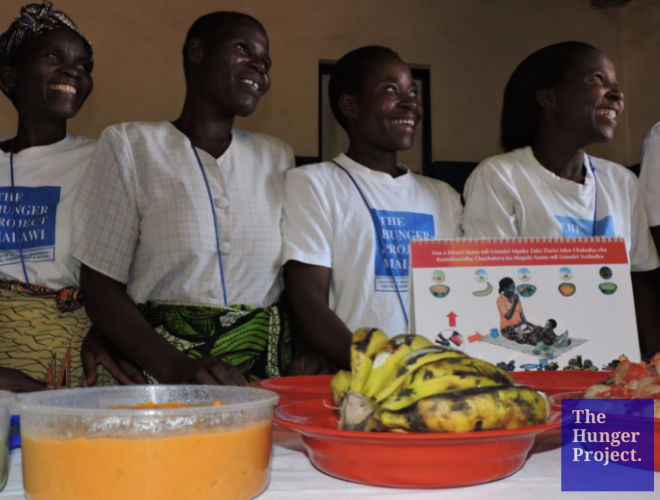
November 24, 2021 – More than 95 activists for community-led nutrition action met to emphasize key community-led strategies and share three case studies.
Good nutrition requires not only affordable access to nutritious food, but an entire local system of community-owned programs – what has often been termed a “food environment.” As identified in the Lancet Series on Maternal and Child Nutrition (Bhutta 2013), it requires a multisectoral approach of nutrition-specific programs (such as supplements, dietary diversity, nutrition education) and nutrition-sensitive programs (such as women’s empowerment, agriculture, food systems, education, employment, social protection, and safety nets). The 2013 Lancet studies found that it requires community ownership to reach the segments of society most at risk.
The “Who” — The Movement for Community Led Development (MCLD) – a civil society initiative comprising 75 INGOs and 1500+ CBOs – hosted a side event on effective community-led action as part of the Tokyo Nutrition for Growth Summit 2021 .
The “What” – Community Engagement has been recognized as a key accelerator in the SDG 3 Global Action Plan (WHO 2019) and Unicef has established minimum standards. (Unicef 2020)
MCLD members have extensive experience with these systematic approaches to transforming food environments (Coonrod 2019) and food systems (Coonrod 2021).
The “how” – The side event was a virtual 90-minute interactive dialogue with leaders from Asia, Africa and Latin America who have facilitated implementing multisectoral nutrition strategies which combine nutrition specific and sensitive programs, and pay particular attention to how to mobilize community understanding, ownership and initiatives. Some of the topics to be explored include:
- How community leaders can learn to effectively bring Essential Nutrition Action (ENA ) education to even the most isolated families particularly to adolescent girls and young women who are often confined to their homes.
- How women’s groups have led successful campaigns to halt child marriage and keep girls in school – critical steps to reduce early pregnancy.
- How grassroots citizens can organize to exert collective voice in order to effectively establish working partnerships with health, social development and agriculture ministries.
- How indigenous communities have reclaimed nutrition-rich traditional foods and overcome the popularity of “junk food.”
- How communities were able to emphasize good nutrition as a key component of the response to protecting communities during COVID-19.
Panelists:
- Luz Dania Velasquez, Alcance Nicaragua
- Grace Chikowi, THP Malawi, on a partnership with Unicef to reduce stunting through implementation of evidence-based high-impact nutrition-specific and nutrition-sensitive interventions at scale in two districts of Malawi.
- Prof. Pierre Kayodé, and Prof. Nadia Fanou-Fogny of the University of Abomey-Calavi, Benin, who collaborated with civil society on a national campaign to promote use of Moringa leaves for better early-childhood nutrition.
- Moderator: Gunjan Veda, Senior Advisor and coordinator of Global Collaborative Research, MCLD.
Key Takeaways:
Community-Led Development in combating malnutrition
Rowlands Kaotcha, Global Vice President and Southern Africa Regional Director, The Hunger Project, and MCLD coordinator for Southern Africa, opened the event by sharing some of the issues facing communities suffering from malnutrition and the promise of community-led development in combating food insecurity. He highlighted key statistics that demonstrate the urgent need for action. For example, global poverty has risen 7% because of COVID-19’s compounding crises of economic downturn, nutrition, and food insecurity. Rowlands explained that we are not on track to achieve SDG 2: Zero Hunger by 2030. We are also four years away from 2025 and no country is close to achieving the targets set at the 2012 World Health Assembly to reduce forms of malnutrition. Yet, some communities have had success in combating malnutrition at the local level, illustrating that community ownership is essential to achieving the SDGs.
Rowlands gave two examples of community-led initiatives to combat food insecurity. A community in the Ntcheu District of Malawi that graduated from a CLD project five years ago engaged in local farming technologies to fight malnutrition during the pandemic. An ex-post evaluation found that poverty has stayed predominately at the same level in the community during the pandemic, and hunger increased by only 3%. Another community in Malawi’s Phalombe district implemented a nutrition-sensitive program designed to improve sanitation. Home gardens and locally made stoves were implemented to increase local autonomy in food production. The villagers testified, “we are making malnutrition history.”
Grace Chikowi, Country Manager for THP-Malawi, emphasized the need for communities to take ownership of their own needs. She detailed how the Malawian government has looked to mobilize communities to battle malnutrition and ensure a flow of information from the communities to the national government. The program sought to address food security at large by developing an integrated approach from farm to kitchen and encouraging community members to take on projects such as home gardens and sharing knowledge on which crops are most resilient across different seasons. Grace stated, “People need to be empowered to engage in crop diversification which is imperative to food security, to make deliberate choices of which foods will address their needs”. THP Malawi also ran demonstrations on different recipes to prepare to ensure nutrient retention of foods. To address malnutrition, THP Malawi has put households on the frontlines.
Citizen organizing to exert collective voice
Luz Dania Velasquez shared examples of the powerful role of community actions, specifically women’s actions to address community needs. Her remarks pertain specifically to a fund in Nicaragua, Manos Unida, that works to give food and funding to families affected by food insecurity due to poverty and natural disasters. She stated, “The project was created due to the growing problem of high prices and lack of financing for farmers to produce. As output and quality of food decreased over time, farmers had to buy cheap food low in nutritious value”. Their response to the problem began in 2008, when Manos Unida set up a community financing group to remedy the situation. With contributions from each community member $1500 was raised and used for community loans. By 2015, members had repaid loans and had agreed to pay interest too. There was a 60% increase in loan application and by 2017, 60 farmers had been provided with funds. The program improved crop selections by aiding farmers to afford to diversify and buy livestock. They have provided thousands of small loans to support small farmers. Luz Dania’s example demonstrates the strength of local ownership and partnership in making development programs successful.
Communities reclaiming nutrition-rich traditional foods
Professors Pierre Kayodé and Nadia Fanou-Fogny presented a powerful example of local wisdom and agricultural technical support in the use of Moringa leaves. These leaves are a superfood: they are rich in nutritional benefits and are easy to grow. The professors undertook bioefficacy studies on the effect of moringa flowers on moderately malnourished children, using a healthy group as a control. The flowers were consumed 5 days a week for 6 months by children while the women used moringa powder on all foods for 3 months. After consuming the leaves for this duration, the results were impressive: the professors saw a 1.8kg per child weight gain, increased growth, improved anemia status and saw an increase of demand for the product; Professor Nadia shared, “We have had a result of 98% of the mothers in the project who love the use of the moringa leaf in their food.” The project also administered nutrition education and taught recipes that are beneficial to health. This partnership of community wisdom, science and academia marks an impressive collaboration across different stakeholders.
Breakout Group 1
Group one discussed successful strategies for community action on nutrition. Describing a lack of resources as a key barrier to expanding access to nutrition, participants in the discussion described key steps that could be taken to support the distribution of nutritious food in communities. Often Nutritious food is expensive and is not often accessible to local people. For example, in Liberia, as a result of the Civil War, issues on food security and hygiene have not been stable and lots of children are malnourished. In Niger, strategies for community action on nutrition include establishing village savings and loans associations, cereal banks to fill in food shortages, and growing gardens with nutritional food supports the local distribution of nutritional food.
Breakout Group 2
This group focused on the importance of local knowledge. We discussed successful strategies for community action on nutrition through using cultural knowledge as an asset and building upon this knowledge to learn about regenerative agriculture and other sustainable farming techniques. Some of the main barriers to community action lie in the formalization and industrialization of agriculture. This has meant that even if some rural communities have the knowledge for farming, they cannot use it because of lack of access. This barrier has also caused unemployment problems in countries like India. The group advocated for the need for stronger partnerships and integration between CSOs and local governments, and funding for local organizations.
Breakout Group 3
This group, which was conducted in Spanish, discussed various strategies undertaken in different countries in Latin America that utilize traditional foods as well as local populations’ traditional methods. For example, a project undertaken in the Mexican state of Oaxaca, after the pandemic struck and food insecurity grew, a project was undertaken and successful in using local foods that grew in the area, that were more accessible and affordable to provide nutrition to areas affected by food insecurity. The group emphasized the need for people to be able to have their cultural and traditional values reflected in their development goals.
Breakout Group 4
Members of the French breakout group discussed other examples of local resources rich in nutrients. Many communities have undertaken integrated nutrition, wherein they consider local needs and availability paired with foods that best benefit health. Some examples were grains formed from cowpea seeds in Burkina Faso or a protein-rich corn and bean broth in the Congo. Group members also emphasized the need for strategies at the national level, and the need for local governments to address food security.
Closing and announcements
MCLD will report back the findings and discussion of this call to N4G to provide them with feedback on the importance of community-led development in combating malnutrition.
Upcoming events for MCLD:
References
Bhutta, Z.A. et al, Evidence-based interventions for improvement of maternal and child nutrition: what can be done and at what cost? The Lancet, Maternal And Child Nutrition| Volume 382, Issue 9890, P452-477, August 03, 2013
Coonrod, J. et al, Transforming food environments through community-led action, UNSCN 44, p 153-159. 2019. https://www.unscn.org/en/Unscn-news?idnews=1976
Coonrod, J. Systems Thinking for Community-led Food Systems. Submission to UNFSS, March 2021. https://mcld.org/2021/03/31/systems-thinking-for-community-led-food-systems/
Coregroup, 2015. Understanding the Essential Nutrition Actions and Essential Hygiene Actions Framework.https://coregroup.org/wp-content/uploads/media-backup/documents/Resources/Tools/ENA_EHA/Understanding_ENA_EHA_Framework.pdf
UNICEF, Minimum quality standards and indicators in community engagement. https://www.unicef.org/mena/reports/community-engagement-standards
WHO, https://www.who.int/initiatives/sdg3-global-action-plan/accelerator-discussion-frames, 2019.


